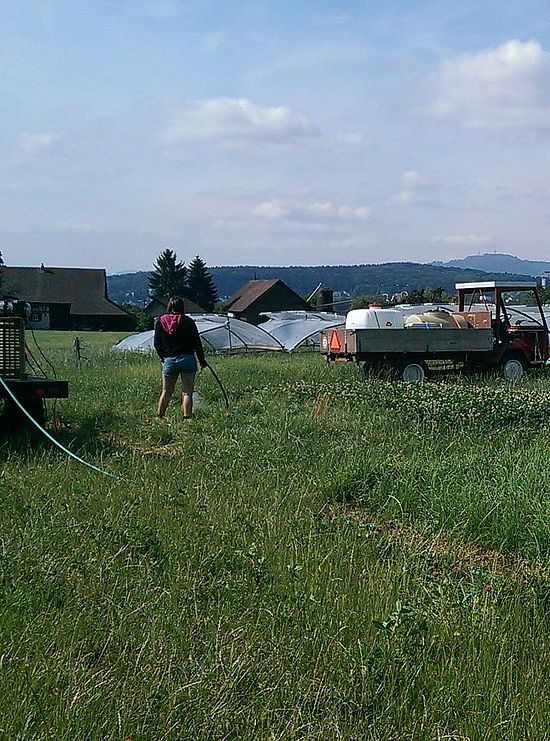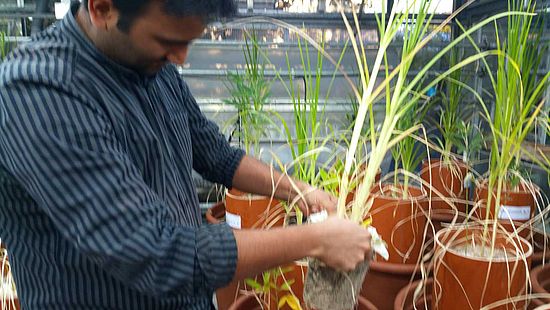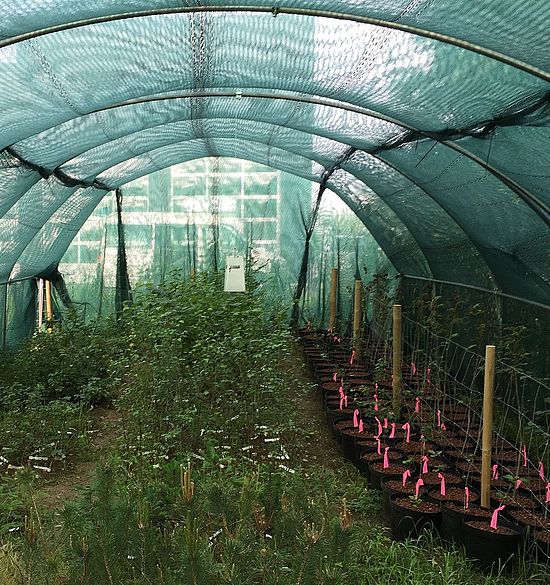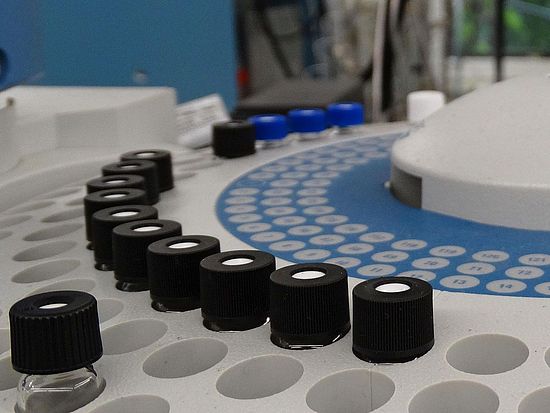
Completed PhD Theses
Reaching natural growth: Sources of variation in plant traits between indoor and outdoor experiments

By Camilo Chiang Silva
Supervisor: Dr. Günter Hoch
Abstract
The work on this thesis was divided in 5 main modules that aimed to:
1) Understand and quantify the natural light quality changes along the day and along a whole season, assess the effect of cloudiness on the natural light spectrum, and correlated these findings to previous studies on light quality effects in trees (Chapter 1)
2) Investigate which light spectral combination of LED-lights can induce the most
natural-like growth in plants grown in indoor chambers with constant climatic conditions (Chapter 2)
3) Identify the minimal degree of environmental fluctuations (of light, temperature and air humidity) necessary to reach natural-like growth in indoor grown plants (Chapter 3) 4) Understand the effect of asynchrony environmental fluctuations in indoor growth chambers, were potential interaction and/or synergies may occur depending of the degree of variability of each environmental variable (Chapter 4) 5) Test possible applications of light fluctuations to improve crop quality and develop software applications for optimized light control of multi-wavelengths LED assimilation lamps (Chapter 5 and Appendix)
Drought effects on carbon and nutrient dynamics in Scots pine
By Leonie Schoenbeck
Supervisor: Prof. Dr. Ansgar Kahmen & WSL
Abstract
Species of the tree genus Pine (Pinus L.) exist all over the world and no other group contains so many attractive forms (Curtis & Bausor, 1943). Scots pine (Pinus sylvestris L.) is currently the most widely distributed pine and occurs throughout all of Eurasia. In the central alpine valleys, Scots pine is growing at the dry border of its distribution range, which involves overcoming periods with extreme low water availability. Although the species is known for its ability to grow on dry and nutrient poor soils, several extreme droughts during the last two decades have caused a 50% dieback of Scots pine in the dry valleys of the Central Alps in Switzerland. The ability of trees to survive drought is determined by their initial health and their resilience to drought, as well as on the characteristics of a drought event - i.e. timing, duration and intensity. The mechanisms underlying drought-induced mortality are still unclear, as well as the recovery process after soil rewetting. Furthermore, possible mitigation or aggravation of drought effects by elevated nutrient availability in the soil has not been studied before. The carbon (C) balance in trees is used as an indicator for C assimilation, growth, defense and storage processes. When trees are exposed to drought, to changes in soil nutrition or sudden defoliation, the C balance may change. In this thesis, the main objective was thus to combine effects of drought and fertilization to study the C and nitrogen (N) dynamics in Scots pine trees.
Seasonal effects of drought on the productivity and fodder quality of temperate grassland species

By Claudia Hahn
Supervisor: Prof. Dr. Ansgar Kahmen
Abstract
During a two-year field experiment we tested the effects of seasonal drought events on the growth rates, physiological activity and fodder quality of several perennial C3 grasses that are commonly used for agricultural production. All tested grasses were subject to at least ten weeks of rainfall exclusion, either in spring, summer or fall of the years 2014 and 2015. The resistance of growth rates varied between seasons. While growth losses were lowest due to drought in spring, losses during summer and fall drought were much higher. Due to strong compensational effects after the release from drought annual net primary productivity was hardly affected by drought in either season. Against our expectations, growth rates of reproductive developmental stages were less affected by drought than those of vegetative stages. Moreover, measurements of leaf water potential and stomatal conductance, as well as carbon discrimination, showed that generative spring growth was least affected by drought. Plants during reproductive stages, thus, may invest more in drought resistance than during vegetative growth. Forage quality patterns, including nitrogen content, crude ash, digestible organic matter and net energy for lactation, were less straightforward in their response to seasonal drought. While quality parameters were reduced under drought in general, the release from drought enhanced forage quality, but seasonal differences could not be perceived.
Transpiration, tracheids and tree rings: linking stem water flow and wood formation in high-elevation conifers
By Richard Louis Peters
Supervisor: Prof. Dr. Ansgar Kahmen
Abstract
Conifers show a biogeographical distribution across a wide range of contrasting environmental conditions, stretching from the Arctic Circle to the equator and Southern Hemisphere. In mountainous ecosystems, conifers can dominate at high elevations with low temperatures severely limiting tree growth and survival. Conifers growing at sites with temperature limiting conditions are highly sensitive to ongoing climatic change, where warmer and drier conditions will impact their growth. Understanding how high-elevation conifers will respond to these changes in climate is critical, as they play a role in regulating terrestrial carbon storage (facilitated by the formation of woody tissue) and water balance (by releasing water to the atmosphere via transpiration). The environmental regulation of wood formation (i.e., tracheid development in conifers), which dictates annual ring-width patterns, is commonly associated with the tree’s photosynthetic activity, while other growth-limiting factors might also be relevant. For example, tree growth requires turgidity in the cambium to exert the pressure necessary for cell expansion, assimilates to lengthen and thicken cell walls, warmth to allow the metabolic reactions to take place, and time for these processes to be completed. Yet, an in-depth study on how important tree hydraulics (i.e., transpiration dynamics) are in regulating “turgor-driven” growth in high elevation forests is lacking.
As part of the LOTFOR project, the general objective of this work is to develop a better mechanistic understanding on how tree hydraulics and environmental factors interact in regulating wood formation and shaping tree rings in high-elevation conifer trees. More specifically, the coupling between stem hydrological cycles and structural carbon dynamics is investigated in the context of increasing temperature and water scarcity. This thesis combines multi-annual records of both intra-annual wood formation data and high-resolution hydraulic measurements within a mechanistic growth model to explain inter- and intra-annual tree growth patterns. To simulate the impact from recent climate change on these mechanisms, a space-for-time experimental setting is applied within the Lötschental, located in the Swiss Alps, where we collected data of two commonly occurring conifer species (Larix decidua Mill. and Picea abies Karst. L.) along an elevation/thermal gradient and contrasting wet and dry sites. Additionally, evaluations are performed on existing methodologies for measuring sap flow and handling large wood anatomical datasets.
Analysing how climate affects tree growth at high elevations requires measurements on inter- and intra-annual growth, frequently obtained from tree rings and wood formation observations, respectively. In CHAPTER 2 of this thesis, more than 150 years of inter-annual growth dynamics along the elevational gradient (derived from tree rings) are assessed in relation to temperature, precipitation and insect activity. An analysis of the recent forest biomass increment increase, derived from the tree-ring width measurements, indicates that the absence of insect outbreaks (since 1981) has caused an equal or even greater impact on carbon sequestration compared to the observed warmer summer temperatures. The presented analysis reveals the relevance of including such biotic drivers and their interactions with climate in models assessing the future productivity and carbon sink capacity of forests. In CHAPTER 4, using the algorithms presented in CHAPTER 3, we monitored intra-annual tracheid development across an 8 °C thermal gradient including two elevational transects (in the Lötschental and Vosges Mountains in France) to investigate cell enlargement and wall thickening dynamics in relation to environmental conditions. Results show that at colder sites, differentiating tracheids compensate for lower rates of cell enlarging and wall thickening by increasing the cell development time, except for the wall-thickening latewood cells. This compensation allows conifer trees to mitigate the influence of temperature on the final tree-ring structure, with important implications for the ring’s size and functioning.
Common mycorrhizal network as facilitator of bioirrigation for rainfed agriculture tested in legume – millet intercropping system

By Devesh Singh
Supervisor: Prof. Dr. Ansgar Kahmen
Abstract
Food security for growing population and achieving the zero hunger target by 2050 is a major challenge for mankind. Sustainable intensification of agriculture, i.e. increased food production without causing environmental damage has been foreseen as the way forward to address this challenge. In this study we tested a sustainable legume – millet intercropping model based on “bioirrigation” and biofertilization to mitigate drought induced yield loss in rainfed areas of arid and semiarid tropics. “Bioirrigation” is based on the principle of hydraulic lift (HL) where transfer of water occurs through roots from wet deep soil layers to dry top soil layers as a consequence of a soil water potential gradient. Specifically, the process of bioirrigation describes the transfer of hydraulically lifted water from a deeprooted plant to a neighbouring shallow-rooted plant. The main challenge for bioirrigation derives from distance between rhizospheres of the two plants, water released into the rhizosphere of bioirrigator is not available to neighbouring plant since it is tightly held up
in to the rhizosphere. In this study, we tested a potential solution to facilitate bioirrigation between rhizosphere of deep-rooted pigeon pea and shallow-rooted finger millet by connecting the rhizosphere through a common mycorrhizal network (CMN) using arbuscular mycorrhizal fungi (AMF).
In this study, we conducted several pot experiments under controlled conditions inside the greenhouse at University of Basel to test the hypothesis of CMN mediated bioirrigation between pigeon pea and finger millet. The results of pot experiments clearly showed that pigeon pea does perform HL, and when roots of pigeon pea and finger millet are connected through AMF network water relations of finger millet are supported by pigeon pea through bioirrigation. In our experimental set up, after testing the role of CMN in pot experiments, we scaled up (approx. 3 times) the pot size to mimic the field like conditions and test if bioirrigation facilitated through CMN can help shallow-rooted to survive a long drought period of 10 to 11 weeks. The results from scaled up pot experiment did not show significant effect of CMN on water-relations (stomatal conductance) of finger millet in intercropping treatments, but finger millet in treatments with CMN had significantly lower foliar damage percentage and mortality than treatments without CMN. The results from pot experiments show the importance of bioirrigation for rainfed agriculture i.e. if bioirrigation based intercropping is practiced, shallow-rooted plants would be able to tolerate the drought period.
To test the efficacy of bioirrigation driven intercropping system, we conducted field trials at two experimental sites (GKVK, Bengaluru and Kolli Hills, Tamil Nadu) in southern India to optimize the spatial arrangement of pigeon pea and finger millet and test its effect on yield and water-relations of finger millet. The field trial results demonstrated that, planting two rows of pigeon pea and flanking eight rows of finger millet showed improved yield of finger millet compared to pigeon pea plants planted in between eight rows of finger millet plants in a mosaic fashion. However, the effect of spatial arrangement varied with change in experimental site. At Kolli Hills site, within row plantation of pigeon pea and finger millet performed similarly to row wise (2 pigeon pea : 8 finger millet). However, the intercropping effect was not driven by the CMN facilitated bioirrigation because finger millet in intercropping treatments had lower leaf water potential than monoculture treatments due to interspecific competition between pigeon pea and finger millet. We envision that sustainable intercropping on the basis of our bioirrigation and biofertilization model will help to design appropriate intercropping system especially in rain-fed areas that could provide sustainable food security, particularly for the marginal farmers in arid and semi-arid tropics.
Physiological responses of six temperate tree species to water limitation

By Lars Dietrich
Supervisor: Prof. Dr. Ansgar Kahmen
Abstract
Direct evidence for the link between stem diameter variations (SDV) and the daily canopy water status, i.e. daily water potentials (Ψ), is rare, particularly for tall trees. It thus remains unclear up to what degree SDV readings are useful to estimate daily canopy Ψ. We measured SDV with point dendrometers at the stem base of tall, mature individuals of six European forest tree species in a near-natural temperate forest and compared them to daily canopy Ψ during the growing seasons of 2014 (wet) and 2015 (dry). SDV were de-trended for growth with two different approaches leading to the socalled tree water deficit (TWD). We found that midday Ψ can be predicted from TWD, independent of the growth-de-trending procedure to obtain TWD from SDV. Further, daily TWD was a better indicator for daily midday Ψ, particularly under dry conditions, than maximum daily shrinkage (MDS), another common quantity derived from SDV. Based on data from six temperate tree species, we conclude that TWD measured at the stem base is a consistent proxy for daily canopy midday Ψ of tall trees over the entire range of measured conditions.
Link to full text (download restricted until 1 June 2020): https://baselbern.swissbib.ch.
Minimum levels and dynamics of carbon reserves in temperate trees at severe carbon limitation

By Raphael Weber
Supervisor: Dr. Günter Hoch
Abstract
Non-structural carbohydrates (NSC, i.e. free sugars and starch) are regarded as freely available carbon (C) reserves in plants. They are often quantified to estimate the C supply status of plants, especially of tall forest trees. However, it is still unclear, whether high NSC concentrations indicate a sufficient C supply and, respectively, if low NSC concentrations indicate an insufficient C supply. Furthermore, the temporal dynamics of NSC in trees under long-term (year-long) C-limitation are still unknown, despite the possibility that NSC concentrations are subject to acclimation. Additionally, it is still unclear, to what extent a sufficient C supply can improve the fitness of trees.
I conducted multiple experiments on young trees to (i) identify the minimum tissue concentrations of NSC in tree organs at lethal C-starvation following complete darkness, (ii) investigate the long-term effects of C-limitation (under 6% light) on growth, gas exchange and C storage of different tree species to identify possible trade¬-offs between biomass production and storage, and to (iii) assess the significance of the presence of NSC pools for the survival of trees under environmental stress, like drought.
At lethal C-starvation, I observed minimum NSC tissue concentrations lower than 20% compared to control concentrations, which I never observed at non-lethal C-limitation. In contrast, I observed higher NSC concentrations (at least 30% compared to controls) during three years of non-lethal C-limitation. No photosynthetic acclimation was observed after years of shading, while NSC generally increased under shade. Manipulation of NSC during drought was not efficient enough to show the effect of stored NSC on drought survival.
This thesis showed, that measurements of substantial NSC concentrations in potentially C-limited tree seedlings or saplings do not exclude the presence of non-lethal C-limitation, while they clearly exclude lethal C-starvation. Thus, lethal C-starvation can be predicted more easily from NSC measurements, than non-lethal C-limitation. These findings improve the predictive value of NSC concentrations, and hopefully help to prevent erroneous assessments about the C-relations of trees.
Biochemical and metabolic effects on hydrogen isotope composition of organic compounds in plants

By Marc-André Francis Cormier
Supervisors: Prof. Dr. Ansgar Kahmen
Summary:
Despite a large unexplained variability in the values, the analysis of the hydrogen (H) isotope composition (δ2H) of plant organic compounds is confidently applied to assess ecohydrological processes in the environment. This is possible because most studies that use the stable H isotopes from plant-derived biomarkers consider the H isotope fractionation that occurs during the biosynthesis of any given compound (2H-εbio) to be constant within a species. Consequently, δ2H values in plant organic compounds are assumed to be mainly driven by the plant's source water δ2H values and the leaf water evaporative 2H-enrichment.There are, however, several indications that 2H-εbio of plant organic compounds can vary and that the δ2H values are also related to the plant's metabolism.
In this thesis, the elucidate the puzzling variability in the δ2H values of plant organic compounds, the influence of the plant's metabolism on the variability of 2H-εbio is specifically explored with regards to the possiblebiochemical mechanisms underlying this variability. In a first study, based on empirical data produced in two separate experiments, it is shown that the 2H-εbio of different compounds in plants is tightly coupled to a plant's carbonand energy metabolism. Based on these data, we develop a conceptual biochemical model that explains how and where 2H-fractionation occurs in the biosynthesis of major plant organic compound classes such as carbohydrates and lipids and what the isotope fractionation processes are that introduce a metabolic signal in δ2H values to these compounds.
In a second study, with δ2H analyses from heterotrophic plants, it is shown that the hydrogen isotope fractionation occurring during the biosynthesis of different organic compounds in plants can explain part of the variability observed in δ2H values across species. Metabolic effects on δ2H values between heterotrophic plants and their autotrophic hostplants differed for different compound classes. The remarkable consistency of the compound 2H as a plant metabolic proxy specific isotope effects between autotrophic host or reference plants and the heterotrophic parasitic or mycoheterotrophic plants points towards a general physiological mechanism thatdetermines these effects and support the model developed in the first study.Finally, with this model, it is mechanistically illustrated that information recorded inthe δ2H values of plant organic compounds goes beyond hydrological signals, but alsocontains important information on the carbon and energy metabolism of a plant. As such we provide the mechanistic basis to introduce hydrogen isotopes in plant organic compounds as new metabolic proxy for the carbon and energy metabolism of plants. Such a new metabolic proxy has the potential to be applied in a broad range of disciplines, including plant and ecosystem physiology, plant breeding, biogeochemistry, paleoecology and Earth system sciences.
Thesis submitted to ETH Zürich.
Ecophysiological responses of four common Swiss tree species to global environmental change

By Nadine Brinkmann
Supervisors: Prof. Dr. Ansgar Kahmen; Prof. Dr. Nina Buchmann
Abstract:
Being a substantial part of the global water cycle, forest ecosystems play an important role in the Earth's climate as they return about 60% of the annual land precipitation back to the atmosphere via transpiration. Predictions of global environmental changefor Europe and Switzerland encompass, e.g., an increase in the frequencies of heatwaves and drought events, such as the European heat wave in 2003 and changes inprecipitation patterns. Temperate forests (including Swiss forests) are expected to be particularly vulnerable to droughts as they are not adapted to such conditions and perform best in mesic environments. Water is a key resource for physiological processesin trees (i.e., transpiration, photosynthesis and growth) and a deeper understanding inhow far different tree species are able to respond in their tree water relations to globalenvironmental changes allows conclusions about a species' sensitivity to such changes. Previous work found temperate tree species to differ in their ecophysiological responseto changes in their environment, however, evidence about the causes of species-specific responses is still rare.
In this doctoral thesis, two studies aim to increase the knowledge on species-specific responses and sensitivities - above and belowground - of four common Swiss tree species (with European distribution) in their tree water relations to environmental changes such as changes in soil water availability. Build on the data and knowledge gained from the second study, a third study focused on resolving the temporal origin of precipitation insoil and xylem water and on understanding how precipitation δ2H and δ18O signals are coupled to soil and xylem water δ2H and δ18O values in a temperate forest, which will further help to interpret plant water isotope models that aim to reconstruct climate.
All three studies in this thesis have been carried out in the framework of the iTREE project funded by the Swiss National Foundation.
Thesis submitted to ETH Zürich.
Partial transfer of leaf water ²H-enrichment and variable biosynthetic fractionation affect the leaf wax n-alkane δ²H values in grasses
By Bruno Gamarra
Supervisors: Prof. Dr. Ansgar Kahmen
Summary:
Leaf wax n-alkanes are long chained hydrocarbons contained in the cuticle of terrestrialplants. Leaf wax n-alkane δ2H values have been successfully used to study the hydrological cycle, plant-water and plant-carbon relationships. However, the physiological and biochemical drivers that shape leaf wax n-alkane δ2H values are not completely understood. It is particularly unclear, why n-alkanes in grasses are typically 2H-depleted compared todicotyledonous plants and why C3 grasses are 2H-depleted compared to C4 grasses. Also, the timing of n-alkane synthesis and the de novo synthesis of n-alkanes in fully matured leaves are still matter of debate. On top, calibration studies designed to resolve sources of heterogeneity in n-alkane δ2H values have exclusively focused on n-alkanes derived from leaves. To solve these uncertainties three studies aimed to explore how leaf wax n-alkane δ2Hvalues in grasses are influenced by plant physiological and biochemical processes.
In the first study the effect of leaf water evaporative 2H-enrichment (LW Δ2H) on n-alkane δ2H valueswas quantified for a range of C3 and C4 grasses that were grown in climate chambers undercontrolled environmental conditions. It was found that only a fraction of the LW Δ2H isimprinted on the n-alkane δ2H values in C3 and C4 grasses. It was also detected that thebiosynthetic hydrogen isotope fractionation (εbio) was different for C3 and C4 grasses. As such, differences between leaf wax n-alkane δ2H values of C3 and C4 grasses would not bedriven by LW Δ2H but largely the result of systematic differences in εbio between these two plant groups.
In the second study the timing of the leaf wax n-alkane synthesis was investigated.Specifically the secondary leaf wax n-alkane synthesis was tested in mature leaf blades of C3 grass species. The experiments showed an incorporation of hydrogen from highly 2H enrichedirrigation water into the wax n-alkanes from mature leaves. Mature grass leavescontinued the synthesis of wax n-alkanes after leaf emergence. The rate of secondary nalkanessynthesis was, however, relatively low and varied among species from 0.09% to1.09% per day. As such, leaf wax n-alkane δ2H values would be determined mainly byenvironmental and physiological conditions in the beginning of the life of a leaf.
In the third study n-alkane concentration and δ2H values of different grass organswere surveyed. Leaves, sheaths, stems, inflorescences and roots were sampled from a totalof 15 species of C3 grasses in temperate and alpine grasslands in Switzerland. It wasdetected that inflorescences had typically much larger n-alkane concentrations compared toother organs while roots had very low n-alkane concentrations. The δ2H values of the carbonautonomous plant organs such as leaves, sheaths and stems were in general more negativecompared to the non-carbon autonomous organs such as inflorescences and roots. Variablen-alkane δ2H values in different plant organs could be the result of differences in the HNADPHbiosynthetic origin in response to the carbon autonomy of the plant organ.Overall, this thesis brings new insights into the natural variability of leaf wax n-alkane δ2H values in grasses. The incomplete transfer of LW Δ2H to the leaf wax n-alkanes δ2Hvalues in grasses can explain why grasses are typically 2H-depleted compared todicotyledonous plants. The low secondary leaf wax n-alkane synthesis in grass leaves aftermaturity suggests that in general leaf wax lipid δ2H values do not record environmental andplant physiological processes beyond leaf maturity. Finally, a different εbio between C3 andC4 grasses and also between grass organs suggests that n-alkane δ2H values have a great potential as indicator of changes in plant carbon autonomy. This has important implicationsfor the interpretation of n-alkane δ2H values in plant physiology and paleoecology.
Thesis submitted to ETH Zürich.
Quick Links
